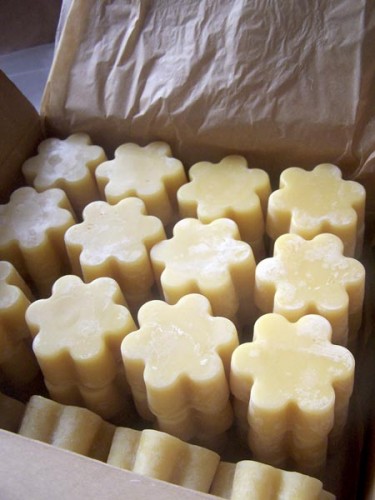The price of beeswax, up or down?
You’ve heard the news. Honeybees are in decline. Yet the price of beeswax has remained relatively stable these last few years. Is there a secret behind the stability? How long will artists who work with beeswax continue to enjoy feel-good prices on their materials?
Beekeepers harvest beeswax from two different areas of the hive. There’s cappings wax that’s culled as part of the honey harvest. And brood comb that beekeepers pull and recycle on a rotating basis from deeper in the hive. While cappings wax is sensitive to fluctuations in the honey harvest, brood comb becomes more available as bees die off and beekeepers reduce the numbers of colonies in their apiaries. So a bad honey year or a high mortality year doesn’t necessarily mean we’re in for a bad wax year, at least not immediately, although enough bad years in a row will disrupt supply.
So what’s the beeswax forecast for 2013?

Cappings wax, filtered and molded for storage by Backyard Bees, photographed by Laura Tyler
I was at a talk in Denver last Saturday presented by USDA bee researcher Jeff Pettis, and while the numbers are still coming in, it’s his hunch that the winter of 2012 – 2013 will go down as the most devastating year to date for bee mortality with some commercial beekeepers reporting losses of 75% or higher. The official numbers will look better than that once they’re in due to how beehives are counted. Regardless of counting methods, this has been a tough winter for the bees.
Interestingly, according to the USDA’s National Honey Report, many beeswax sellers are holding steady on their prices even though stock is low.
Current wholesale prices quoted exclusively for white, cleaned beeswax are steady and for 1lb block units at $5.50 to $5.75 mostly $5.50 and for 50lb block units at $4.50 to $5.00 mostly $4.75. Price quotes taken for bulk orders above 50lbs are $2.20 to $3.50 mostly $3.50 for white/light, cleaned beeswax. Retail white and cleaned beeswax prices reported are $16.00 to $20.00 per pound mostly $18.00. Many beeswax sellers have held their prices however, are showing very low supply inventories.
In other words: Stock up.
LINKS:
National Honey Report, March 2013
Annual Honey Report Analysis
Thank you for this important post, Laura. I find USP (pharmaceutical grade white) beeswax higher than your quotes. Indeed the price has risen twice in the last three months.
Thanks for the comment, Hylla. It was you who tipped me off to the fact that the price of beeswax is changing. Our bees aren’t producing wax or honey at near the rate they used to. We may be on the cusp of scarcity.
Thanks for posting this, Laura. We certainly need to pay attention to what’s happening with the bees, who produce our most important resource for painting as well as making possible the development of our fruits and vegetables. Did the USDA researcher say why this past winter was so particularly hard on bees? Thanks for staying so knowledgeable about this.
Thanks for the question, Nancy. The party line as presented by Jeff Pettis is that it’s a tri-part combo of external stressors: pesticides, pathogens and poor nutrition that are continuing to undermine the bees. He presented some fascinating research on fertilized queens showing how pesticide exposure may be interfering with sperm quality. (Did you know you can dissect a honeybee queen, remove her spermatheca and make a judgement about sperm quality based on visual inspection alone?) This jibes with what we’ve seen in the field these last two years: Mega-fertility issues; bees trying to re-quen themselves repeatedly; breaks in the brood cycle; poorly distributed brood; just a general failure to thrive.
http://www.sciencedirect.com/science/article/pii/S0167587712002656
That is really something! Humans are having fertility problems with sperm too. I had read that some chemicals mimicked estrogen and/or depressed testosterone but bees don’t have these hormones, I wouldn’t think. It’s strange that the same problem is occurring, however. Here’s a link http://www.sciencedaily.com/releases/2009/01/090118200636.htm
The more I read, the more I wonder. This is interesting, Nancy. Thanks for posting.
Great view and insight into the USA market; do you have linked associations around the world ( Europe, Asia, India, New Zealand, South Africa or other ).
Thanks
JP
Thanks, John. Linked associations? I’m not sure what that means. Would you like to clarify?
I was wondering if there is any update for 2015 prices (yes this is very late posting).
Is it possible to provide any wholeslae supplier? All I can find are Chinese ones.
Hi, Jeff. Check out the latest National Honey Report dated February 18, 2015: http://www.ams.usda.gov/mnreports/fvmhoney.pdf
What is the current price of beeswax in 2017 bulk and retail?
The beekeeping trade magazines, Bee Culture and American Bee Journal, do a good job tracking and publishing honey and wax price info. Here’s a piece from Bee Culture dated November 2016. http://www.beeculture.com/december-regional-honey-price-report/